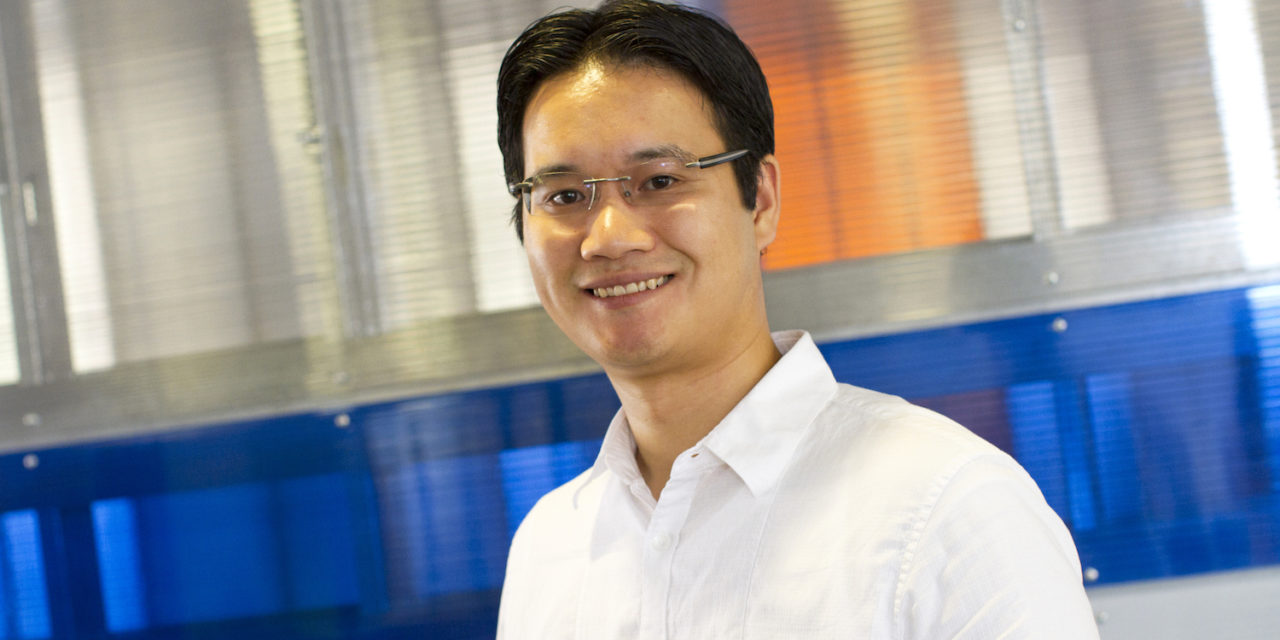
NSF CAREER Award winner reimagines nanocrystals for new technology

Above: Robert Wang is looking to help bridge this technological gap by creating new high frequency phononic crystals with a CAREER Award from the National Science Foundation. Photographer: Jessica Hochreiter/ASU
Light can be manipulated to do amazing things. During a presentation, a laser pointer directs your audience’s attention. A photographer allows just enough light through an aperture to capture the perfect photo. But what about sound or heat?
Technically speaking, light, sound and heat are very similar. Light is carried by electromagnetic waves called photons, whereas sound and heat are carried by vibrational waves called phonons. Nonetheless, all three are carried by waves and therefore follow the same physical laws.
Because they are so similar, shouldn’t every photon device that controls light, such as a one-way mirror, have a counterpart phonon device that controls sound or heat?
Despite this likeness, technological advancements for control of sound and heat lag far behind those of light.
Robert Wang, an assistant professor of mechanical engineering at Arizona State University’s Ira A. Fulton Schools of Engineering, is looking to help bridge this technological gap by creating new, high frequency phononic crystals. These phononic crystals can form the foundation for a new set of devices that control sound and heat, like phononic filters, mirrors, resonators and waveguides.
When researchers make phononic crystals, they create a periodic assembly of alternating hard and soft materials. These structures have been created for manipulating sound in kilohertz frequencies with millimeter-scale objects. Creating these structures for heat in frequencies greater than 100 gigahertz is much more challenging because it requires assembly with nanometer-scale objects. That’s one million times smaller than the structures made for sound.
In order to access this nanometer-scale assembly system, Wang uses colloidal nanocrystals, which spontaneously assemble themselves into special structures called superlattices. These superlattices naturally possess the periodic, alternating hard and soft materials that phononic crystals require. In addition, these superlattices exhibit periodicity in three dimensions, instead of the two dimensions in typical phononic crystals. With three-dimensional periodicity, these colloidal nanocrystal superlattices can control phonons traveling in any direction.
This innovative use of colloidal nanocrystals to access nanometer length scales and three-dimensional periodicity is what Wang believes caught the attention of the National Science Foundation. The NSF awarded him a $562,500, five-year CAREER Award for his proposal, “Phononic Properties of Colloidal Nanocrystal Superlattices.”
“I believe my proposal appealed to the NSF because it brings together a new class of materials with unique characteristics that address long-standing challenges within the phononic crystal community,” Wang said. “There are fundamental and convincing arguments that show these nanocrystals are a promising new material for the creation of high frequency phononic crystals.”
The Fulton Schools’ School for Engineering of Matter, Transport and Energy has provided an environment with a unique intersection of engineering disciplines– mechanical, chemical, materials science and aerospace engineering– for Wang to develop his research
“SEMTE is pretty much a perfect match for me,” Wang said. “While my formal education is in mechanical engineering, my research heavily resembles materials science and chemical engineering.”
Because three-dimensional phononic crystals in this high frequency range have not been created before, there are many long-term possibilities for Wang’s research. If UV filters can remove harmful photons from sunlight, why couldn’t new filters be made that remove specific phonons from heat? If fiber optic cables can transport light around corners, a new device crafted using Wang’s innovations could do the same with phonons.
“These phononic crystals are a key building block for creating a suite of tools that control high frequency vibrational waves,” Wang said.
Additionally, Wang plans to integrate his concepts with laboratory modules for undergraduates, curriculum for his nanoscale heat transfer course and educational activities to engage K-12 students in a partnership with the Science is Fun program in the LeRoy Eyring Center for Solid State Science.



































